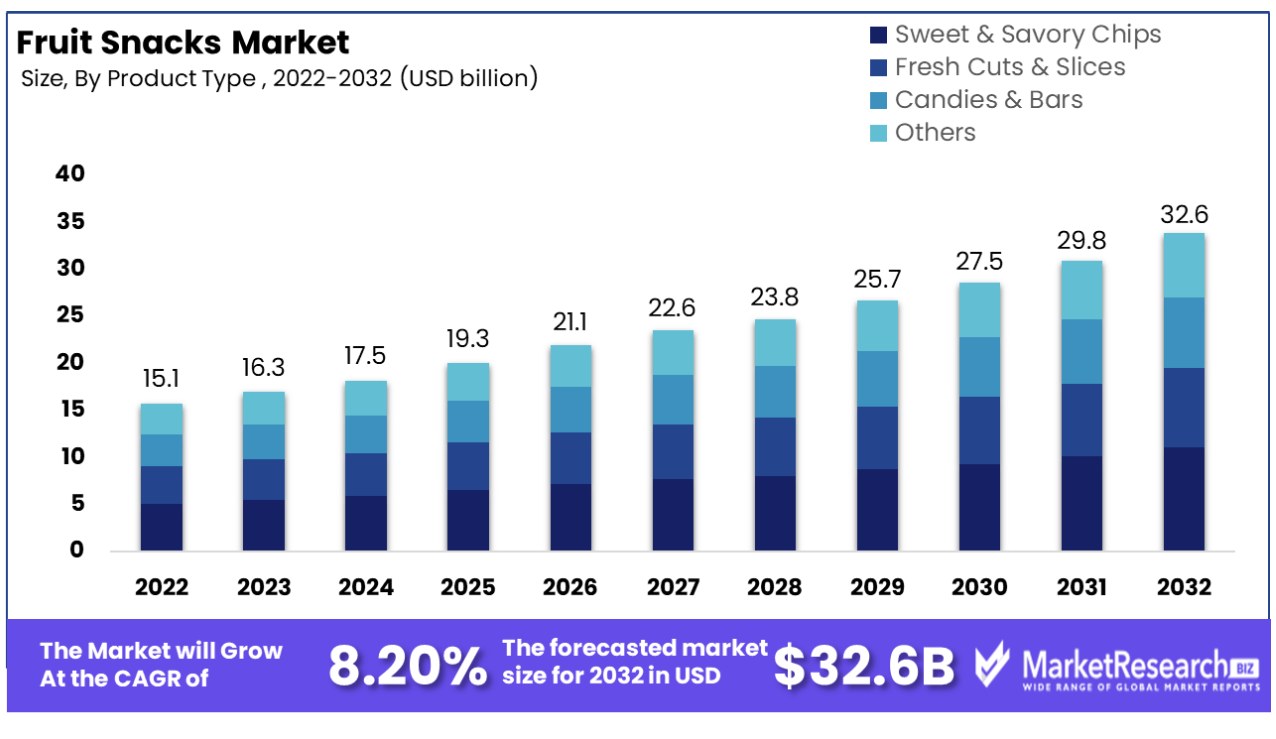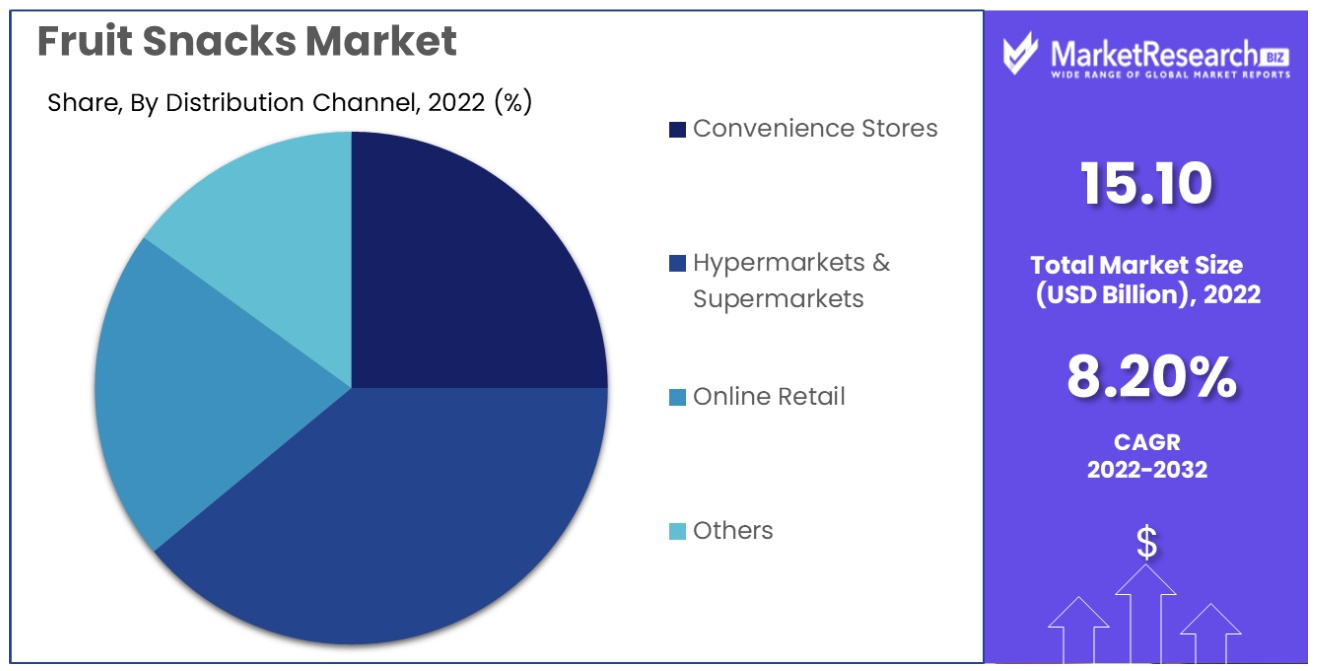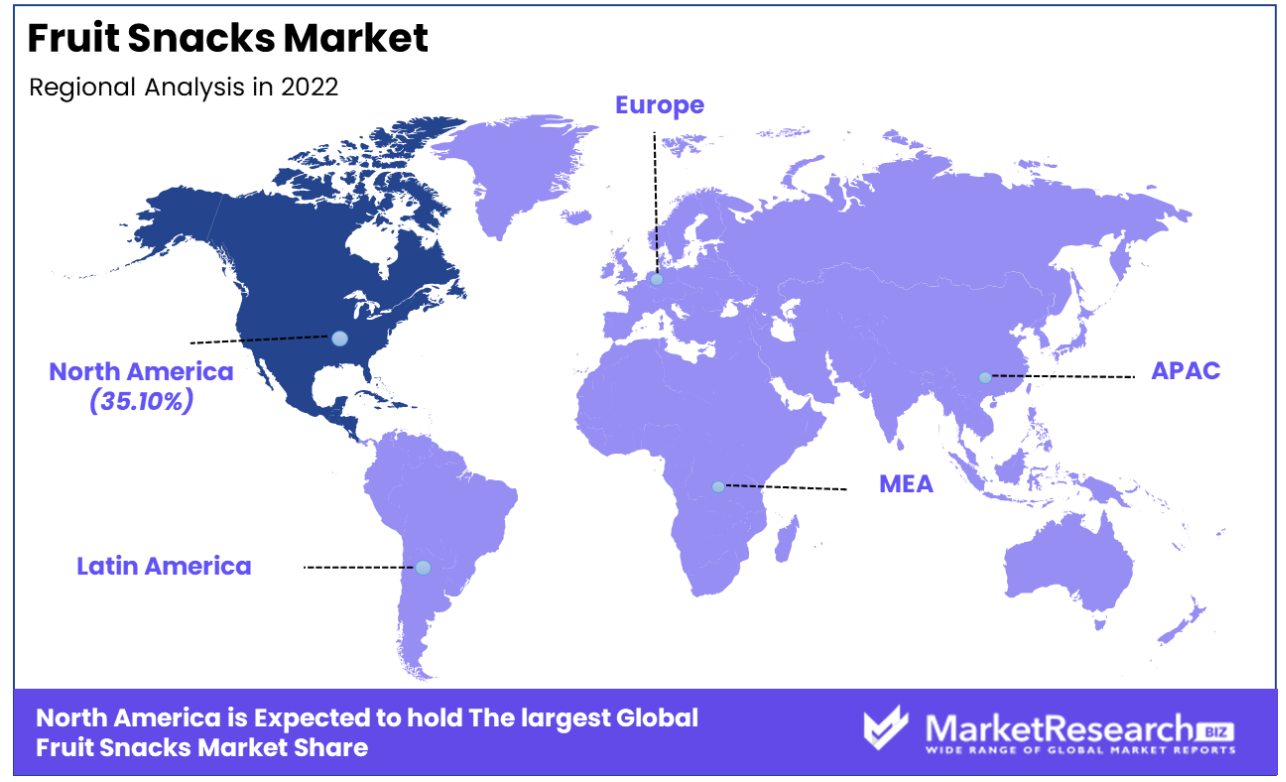
Fruit Snacks Market By Fruit Type(Apple, Mango, Banana, Pineapple, Others), By Product Type(Sweet & Savory Chips, Fresh Cuts & Slices, Others), By Distribution Channel(Convenience Stores, Hypermarkets & Supermarkets, Others), By Region And Companies - Industry Segment Outlook, Market Assessment, Competition Scenario, Trends, And Forecast 2023-2032
-
37725
-
Nov 2023
-
137
-
-
This report was compiled by Shreyas Rokade Shreyas Rokade is a seasoned Research Analyst with CMFE, bringing extensive expertise in market research and consulting, with a strong background in Chemical Engineering. Correspondence Team Lead-CMFE Linkedin | Detailed Market research Methodology Our methodology involves a mix of primary research, including interviews with leading mental health experts, and secondary research from reputable medical journals and databases. View Detailed Methodology Page
-
Quick Navigation
- Fruit Snacks Market Size, Share, Trends Analysis
- Fruit Snacks Market Dynamics
- Fruit Snacks Market Segmentation Analysis
- Fruit Snacks Industry Segments
- Fruit Snacks Market Growth Opportunity
- Fruit Snacks Market Regional Analysis
- Fruit Snacks Industry By Region
- Fruit Snacks Market Key Player Analysis
- Fruit Snacks Industry Key Players
- Fruit Snacks Recent Development
- Report Scope:
The fruit snacks market was valued at USD 15.10 Billion in 2022. It is expected to reach USD 32.6 Billion by 2032, with a CAGR of 8.20% during the forecast period from 2023 to 2032.
The surge in demand for rich fiber food items and the rise in demand for essential vitamins and minerals are some of the main driving factors for the fruit snacks market. Natural food products are extracted from plants and are edible for consumption. Natural produce has several health benefits when it is consumed in raw or processed form, either in fruit sandwiches or salads.

For example, oranges are a rich source of vitamin C which is important for the repair and development of body tissues. Most of them are sweet and ready-to-eat food without any preparation for cooking. Most of the children are consuming processed or ready-to-eat fruits that are nutritionally poor and bad for their health. Such types of produce have artificial colors, added flavors, and refined sugar that has high calories.
Many consumers are getting more conscious about their diet and lifestyle. They are getting more inclined to the consumption of natural product that is nutritional and healthy. Fruit snacks are the most preferred food for consumption as they decrease the risk of many diseases especially they lower the risk of cardiac diseases as well as type 2 diabetes. The natural product helps to regulate blood pressure and decrease the risk of forming certain cancers and many more diseases. Some of the natural products also help to prevent eye diseases and decrease the chance of dementia. Natural fruits have antioxidants that fight free radicals.
In the food and beverages industry, manufacturers are now focusing on the production of natural fruit snacks without adding any artificial preservatives and sugar in order to meet the consumer’s demand. Manufacturers are producing the form of fruit bars and chocolates that are famous among kids and teenagers.
Moreover, fruit snacks are made with less processing due to which there is minimal chance of loss in nutrients during the production. The online vendors are also aiming to enhance the buying methods for consumers by offering security and stability. Consumers are often used to purchasing from the online platform in order to save time as it offers many varieties of fruit snack items. The online and e-commerce stores play a vital role in increasing their market revenue which will help in market expansion of the fruit snacks in the forecast period.
Fruit Snacks Market Dynamics
Evolving Healthy Food Trends Drive Fruit Snacks Market Growth
The shift towards healthier eating habits is a key propellant for the fruit snacks market. As consumers increasingly opt for nutritious alternatives to traditional snacks, fruit snacks emerge as a favorable option. This trend leverages their natural appeal - their nutritional benefits and perceived wholesomeness.
Industry players are capitalizing on this by innovating in flavor, texture, and packaging, aligning with the health and wellness movement. This alignment is not merely a response to current demands but a strategic positioning for long-term relevance in a health-conscious consumer market.
Rising Demand for Healthier Snacking Options Fuels Market Expansion
The escalating consumer preference for healthier snacking options is fueling growth in the fruit snacks market. This demand stems from a growing awareness of the health implications associated with processed snacks. Fruit snacks, with their natural sugar and nutrient profile, stand as an attractive alternative.
This consumer shift is prompting manufacturers to focus on clean labels, transparency, and ingredient integrity, thus fostering trust and loyalty in the market. The ongoing trajectory suggests a sustained market expansion, as health-centric eating habits become deeply ingrained in consumer lifestyles.
Preference for Convenient and Nutrition-Rich Refreshments Augments Market Dynamics
The increasing preference for convenient, nutrition-rich refreshments is significantly influencing the fruit snacks market. Today's fast-paced lifestyle demands quick, yet healthy eating options. Fruit snacks meet this need by offering a balance of convenience and nutrition.
They serve as an easy, on-the-go solution for health-conscious consumers who do not wish to compromise on taste or nutritional value. This preference is likely to continue driving innovation in product offerings and packaging solutions, ensuring that fruit snacks remain a staple in the diet of the modern, health-aware individual.
Launch of Fruit Snacks as an Ingredient Stimulates Market Innovation
The introduction of fruit snacks as an ingredient in various food products is a novel growth driver in the market. This trend reflects the versatility, extending their appeal beyond standalone consumption. By integrating into baked goods, cereals, and other products, fruit snacks add a healthful and flavorful dimension.
This integration not only diversifies the market but also enhances the appeal of products in which they are incorporated. The potential for cross-industry collaboration and innovation is vast, indicating a promising growth trajectory for the fruit snacks market rooted in versatility and health appeal.
Increased Demand for On-The-Go Healthy Snacking Products Restrains Fruit Snacks Market Growth
The escalating demand for on-the-go healthy snacking options presents a big challenge for the fruit snacks market. While snacks align with the broader trend of health-conscious eating, they often fail to fully meet the evolving expectations of consumers seeking variety and innovative health benefits.
Modern consumers, increasingly aware of nutritional content, are gravitating towards snacks that offer added health benefits like protein or fiber enrichment, which are not typically associated with traditional snacks. This mismatch between consumer expectations and product offerings limits the fruit snack market's ability to capitalize on the growing healthy snacking trend.
Challenges in Sourcing High-Quality Fruits Restrains Fruit Snacks Market Growth
Securing a consistent supply of high-quality fruits, essential for producing premium produce snacks, poses a significant challenge, especially during the off-season. This issue is exacerbated by factors like climate change, which affects crop yields and quality, and global supply chain disruptions.
The reliance on seasonal availability not only impacts the consistency of product quality but also leads to fluctuating production costs. These sourcing challenges can lead to higher retail prices or compromised product quality, both of which can deter consumers and restrict market growth.
Lack of Product Diversification and Innovation Restrains Fruit Snacks Market Growth
A notable constraint in the fruit snacks market is the lack of diversification and innovation in some segments. While certain brands have successfully integrated novel flavors and textures, a significant portion of the market remains stagnant, offering limited variety.
This lack of innovation hinders the ability to attract new customer segments or retain existing ones seeking novelty and variety in their snacking choices. As consumers' palates become increasingly sophisticated and their demand for unique snacking experiences grows, the segments of the fruit snacks market that fail to innovate risk losing market share to more dynamic competitors.
Fruit Snacks Market Segmentation Analysis
Fruit Type Analysis
Apple-based fruit snacks represent a significant portion of the market. Their dominance can be attributed to the universal appeal and availability of apples, along with their versatile flavor profile that pairs well with various additives and preparations. Additionally, apples are a rich source of fiber and antioxidants, aligning with the growing consumer demand for health-oriented snacks. Market trends indicate a sustained preference for Apple snacks across diverse demographics, solidifying its position as a market leader.
Mango and banana snacks, while not as dominant, are vital for market diversity and cater to specific consumer preferences. Mango snacks are gaining popularity in regions where is a dietary staple, offering a tropical, sweet alternative. Banana snacks, known for their convenience and energy-boosting properties, are becoming increasingly popular in health-conscious and younger demographics. These segments, though smaller, contribute to the market's growth by appealing to niche tastes and dietary requirements.
Product Type Analysis
The sweet and savory chips segment leads in the fruit snacks market. This popularity stems from the evolving snacking habits of consumers who seek convenient, yet healthier alternatives to traditional snacks. These products strike a balance between health and indulgence, appealing to a broad consumer base. The versatility in food flavor profiles, from classic to exotic, further enhances their market appeal. The trend toward innovative flavor combinations and healthier snacking options continues to drive growth in this segment.
Fresh cuts and slices offer a convenient and healthy snacking option, particularly appealing to health-conscious consumers and those seeking natural, minimally processed foods. This segment benefits from the rising demand for fresh, ready-to-eat produce, particularly in urban areas where time constraints influence food choices. While this segment is smaller compared to sweet and savory chips, its growth is bolstered by increasing health awareness and the convenience it offers.
Distribution Channel Analysis
Convenience stores are the primary distribution channel for snacks, largely due to their accessibility and the impulse-buy nature of snacking. The strategic placement of fruit snacks in these stores, often near checkout counters, significantly boosts sales. This segment's dominance is reinforced by the widespread network of convenience stores in both urban and rural areas, making snacks readily available to a broad consumer base.
Hypermarkets and supermarkets play a crucial role in the distribution of produce snacks, offering a wide selection under one roof. This segment caters to consumers who prefer to buy in bulk or seek a wider variety. The presence of various brands and products in these outlets facilitates comparison and choice, contributing to the segment's growth. The trend towards retail consolidation and the expansion of supermarket chains further enhance the role of this channel in the fruit healthy snacks market.

Fruit Snacks Industry Segments
By Fruit Type
- Apple
- Mango
- Banana
- Pineapple
- Berries
- Mixed
- Others
By Product Type
- Sweet & Savory Chips
- Fresh Cuts & Slices
- Candies & Bars
- Others
By Distribution Channel
- Convenience Stores
- Hypermarkets & Supermarkets
- Online Retail
- Others
Fruit Snacks Market Growth Opportunity
Corporate Wellness Programs Offer Growth Opportunities for Fruit Snacks Market
Corporate wellness programs significantly contribute to the growth rate of the fruit snacks market. These programs, increasingly adopted by companies, focus on improving employee health and well-being. As a result, there's a growing demand for healthier snack options in the workplace. Fruit snacks, with their natural sugar and nutrient content, are perfectly positioned to meet this demand. Recent trends show a surge in corporate health initiatives, which correlates with increased consumption of healthier snack alternatives. This alignment with corporate wellness goals presents a substantial opportunity for the fruit snacks market, both in terms of volume and diversity of products offered.
Government Laws Promoting Healthy Eating Habits Open Opportunities for Fruit Snacks Market
Legislative measures aimed at promoting healthy eating habits present significant growth opportunities for the fruit snacks market. Governments worldwide are increasingly implementing laws that encourage or even mandate healthier food choices in schools, public institutions, and within broader consumer markets. These regulations often involve reducing sugar and unhealthy fats in snacks, creating a favorable environment for fruit snacks. Given their health-centric profile, fruit snacks are becoming a go-to option for consumers seeking compliance with these new dietary guidelines. The synergy between governmental health objectives and the intrinsic benefits of snacks positions the market for robust growth, driven by both policy and consumer preference shifts.
Fruit Snacks Market Regional Analysis
North America Dominates with a 35.10% Market Share
North America's commanding 35.10% share in the fruit snacks market is primarily driven by evolving consumer preferences and lifestyles. The region's fast-paced, health-conscious population increasingly opts for convenient, nutritious snacking options. Additionally, the widespread presence of major food companies, adept at innovation and marketing, significantly contributes to this market dominance. These corporations continually introduce new flavors and health-centric variants, appealing to a broad consumer base, from children to health-conscious adults.
The future trajectory of North America in the fruit snacks market appears promising. Anticipated trends include a surge in demand for organic and non-GMO snacks, catering to the growing health and environmental concerns. Technological advancements in food processing and preservation are expected to enhance product quality and variety, further appealing to health-conscious consumers. Additionally, the region's strong economic fundamentals and continued innovation in snacking options are likely to sustain and possibly enhance its market share in the global arena.

Europe: Embracing Healthier Alternatives
Europe's fruit snacks market is gaining momentum, driven by a growing consumer preference for healthier snack alternatives. The region's focus on health and wellness, along with stringent food safety and quality regulations, plays a crucial role in shaping consumer choices. The rising demand for organic and naturally sourced snacks is creating opportunities for market expansion. Additionally, Europe's strong emphasis on sustainable and ethical food production resonates well with the contemporary consumer ethos, setting the stage for continued growth in this sector.
Asia Pacific: Rapid Growth and Diversification
In Asia Pacific, the fruit snacks market is experiencing rapid growth, fueled by increasing disposable incomes and a burgeoning middle class. The region's diverse culinary traditions and growing urbanization contribute to a rising appetite for convenient and healthy snacking options. Moreover, the expanding retail sector and e-commerce platforms in Asia Pacific provide easy access to a wide range of fruit snacks, catering to varied consumer tastes. This market dynamism, backed by demographic and economic shifts, positions Asia Pacific as a fast-growing and potentially influential player in the global fruit snacks market
Fruit Snacks Industry By Region
North America
- The US
- Canada
- Rest of North America
Europe
- Germany
- France
- The UK
- Spain
- Italy
- Russia
- Netherlands
- Rest of Europe
Asia-Pacific
- China
- Japan
- South Korea
- India
- New Zealand
- Singapore
- Thailand
- Vietnam
- Rest of Asia Pacific
Latin America
- Brazil
- Mexico
- Rest of Latin America
Middle East & Africa
- South Africa
- Saudi Arabia
- UAE
- Rest of Middle East & Africa
Fruit Snacks Market Key Player Analysis
In the burgeoning fruit snacks market, a tapestry of key players has emerged, each contributing uniquely to the sector's evolution. Companies like Crunchies Natural Food, Bare Foods, and Crispy Green are pivotal in driving the trend towards natural and health-conscious offerings, capitalizing on consumer demands for wholesome, minimally processed snacks. Their strategic positioning around authenticity and nutritional value echoes the market's growing health awareness.
Mount Franklin Foods and Flaper, leveraging their extensive distribution networks, have become instrumental in ensuring widespread market penetration, highlighting the importance of accessibility in consumer reach. Nutty Goodness and Whitewave Services, with their focus on innovative flavor profiles and ingredient combinations, illustrate the market's appetite for variety and experimentation.
Paradise, Tropical Foods, and Ganong Bros Ltd, through their diverse product portfolios, reflect the market's competitive nature and the need for differentiation. Their ability to cater to a broad spectrum of tastes and preferences underscores the market's dynamic consumer base.
A.S. Watson Group and PT Monysaga Prima, with their strong regional footholds, highlight the significance of geographical nuances in the fruit snacks market. They showcase how localized tastes and cultural preferences can shape product offerings and market strategies.
Lastly, General Mills Inc., a behemoth in the snack industry, demonstrates the impact of large-scale operations and brand power in influencing market trends and consumer choices. Their presence signifies the blend of tradition and innovation in shaping the fruit snacks landscape. Collectively, these companies not only propel the fruit snacks market forward but also illustrate the diverse strategies – from health-focused products to innovative flavors and robust distribution channels – that are key to thriving in this dynamic sector.
Fruit Snacks Industry Key Players
- Crunchies Natural Food
- Bare Foods
- Crispy Green Inc.
- Mount Franklin Foods
- Flapper
- Nutty Goodness
- Whitewave Services
- Paradise
- Tropical Foods
- Ganong Bros Ltd
- A.S. Watson Group
- PT Monysaga Prima
- General Mills Inc.
- Keurig Dr. Pepper Inc.
- Kellogg Co.
- Welch Foods Inc.
- SunOpta Inc.
- Sunkist Growers Inc.
- Nestle S.A.
- PepsiCo Inc.
- The Kraft Heinz Company
Fruit Snacks Recent Development
- In 2023, Dole announced intentions to create organic fruit snacks. Dole hopes to broaden its market reach by capitalizing on the organic food boom. Dole's new brand will target consumers seeking organic, flavorful, and handy snacks.
- In 2022, Kellogg's $15 billion purchase of Fruit Gushers was another market milestone. Kellogg's fruit snacks, which include Pop-Tarts and Rice Krispies Treats Snap Crackle Poppers, will benefit from this deal. Kellogg's can boost its fruit snack market share by acquiring Fruit Gushers.
- In 2021, General Mills, Kellogg's, and Dole introduced intriguing new products in the global fruit snacks market. General Mills introduced healthier. General Mills created these organic fruit snacks for health-conscious people. The new brand promises nutritious snacks and high-quality nutrients.
Report Scope:
Report Features Description Market Value (2022) USD 15.10 Bn Forecast Revenue (2032) USD 32.6 Bn CAGR (2023-2032) 8.20% Base Year for Estimation 2022 Historic Period 2016-2022 Forecast Period 2023-2032 Report Coverage Revenue Forecast, Market Dynamics, COVID-19 Impact, Competitive Landscape, Recent Developments Segments Covered By Fruit Type(Apple, Mango, Banana, Pineapple, Berries, Mixed, Others), By Product Type(Sweet & Savory Chips, Fresh Cuts & Slices, Candies & Bars, Others), By Distribution Channel(Convenience Stores, Hypermarkets & Supermarkets, Online Retail, Others) Regional Analysis North America - The US, Canada, Rest of North America, Europe - Germany, France, The UK, Spain, Italy, Russia, Netherlands, Rest of Europe, Asia-Pacific - China, Japan, South Korea, India, New Zealand, Singapore, Thailand, Vietnam, Rest of Asia Pacific, Latin America - Brazil, Mexico, Rest of Latin America, Middle East & Africa - South Africa, Saudi Arabia, UAE, Rest of Middle East & Africa Competitive Landscape Crunchies Natural Food, Bare Foods, Crispy Green Inc., Mount Franklin Foods, Flapper, Nutty Goodness, Whitewave Services, Paradise, Tropical Foods, Ganong Bros Ltd, A.S. Watson Group, PT Monysaga Prima, General Mills Inc., Keurig Dr. Pepper Inc., Kellogg Co., Welch Foods Inc., SunOpta Inc., Sunkist Growers Inc., Nestle S.A., PepsiCo Inc., The Kraft Heinz Company Customization Scope Customization for segments, region/country-level will be provided. Moreover, additional customization can be done based on the requirements. Purchase Options We have three licenses to opt for: Single User License, Multi-User License (Up to 5 Users), Corporate Use License (Unlimited User and Printable PDF) -
-
- Crunchies Natural Food
- Bare Foods
- Crispy Green Inc.
- Mount Franklin Foods
- Flaper
- Nutty Goodness
- Whitewave Services
- Paradise
- Tropical Foods
- Ganong Bros Ltd
- A.S. Watson Group
- PT Monysaga Prima
- General Mills Inc.
- Keurig Dr. Pepper Inc.
- Kellogg Co.
- Welch Foods Inc.
- SunOpta Inc.
- Sunkist Growers Inc.
- Nestle S.A.
- PepsiCo Inc.
- The Kraft Heinz Company




